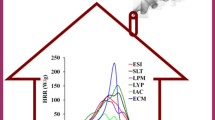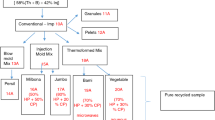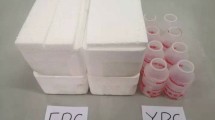Summary
Experiments have been carried out on different Porapak samples to determine their speed of thermal degradation and the composition of their pyrolysis products.
While their thermal stability as determined by themogravimetry would suggest markedly highly temperatures, it is shown that the maximum temperature for their use in gas chromatography should not exceed 200°C for Porapak P and 300°C for Porapak Q.
The main pyrolysis products of the Porapak types under consideration are the meta and para isomers of diethyl benzene, divinyl benzene, and mainly of ethylvinyl benzene, and in addition styrene.
Zusammenfassung
Durch mehrere Versuche, die an verschiedenen Porapak-Proben durchgeführt wurden, läßt sich die Geschwindigkeit ihrer themischen Zersetzung und die Zusammensetzung der Pyrolyse-Produkte bestimmen.
Obwohl sich aus der thermischen Stabilität, die durch Thermogravimetrie bestimmt wurde, merklich höhere Temperaturen ergeben würden, wird gezeigt, daß die Höchsttemperature bei der Anwendung für die Gas-Chromatographie bei Porapak P 200°C und bei Porapak Q 300°C nicht überschreiten sollte.
Die hauptsänchlichen Pyrolyseprodukte der untersuchten Porapak-Typen sind die meta- und para-Isomeren von Diäthylbenzol, Divinylbenzol und besonders Äthylvinylbenzol, zu denen noch Styrol kommt.
Sommaire
Diverses expérences pratiquées sur différents échantillons de Porapak permettent de déterminer sa vitesse de dégradation thermique et la composition des produits de pyrolyse.
Alors que la stabilité thermique, déterminée par thermogravimétrie, conduirait à des températures nettement plus élevées, on montre que la température maximum d'emploi en chromatographie en phase gazeuse ne devrait pas dépasser 200°C pour le Porapak P et 300°C pour le Porapak Q.
Les principaux produits de pyrolyse des Porapak étudiés sint les isomères méta et para du diéthylbenzène, du divinylbenzène et surtout de l'éthylvinylbenzène, auxquels vient s'ajouter le styrène.
Similar content being viewed by others
Bibliographie
A. B. Littlewood, Gas Chromatography, Academic Press, Londres 1962
D. Zarazir, P. Chovin, G. Guiochon, Chromatographia à paraitre
O. L. Hollis, W. V. Hayes, J. of Gas Chrom.4, 235 (1966)
O. L. Hollis, Anal. Chem.38, 309 (1966)
A. Zlatkis, H. R. Kaufmann, J. of Gas Chrom.4, 240 (1966)
J. H. Merle d'Aubigne, G. Guiochon, Recherches 1970, à paraitre
O. L. Hollis, U. S. Patent no 3.357.158 (1967)
Author information
Authors and Affiliations
Rights and permissions
About this article
Cite this article
Merle, J., Guiochon, G. Etude du comportement thermique des polystyrenes reticules, type porapak. Chromatographia 3, 153–162 (1970). https://doi.org/10.1007/BF02269015
Received:
Accepted:
Issue Date:
DOI: https://doi.org/10.1007/BF02269015




